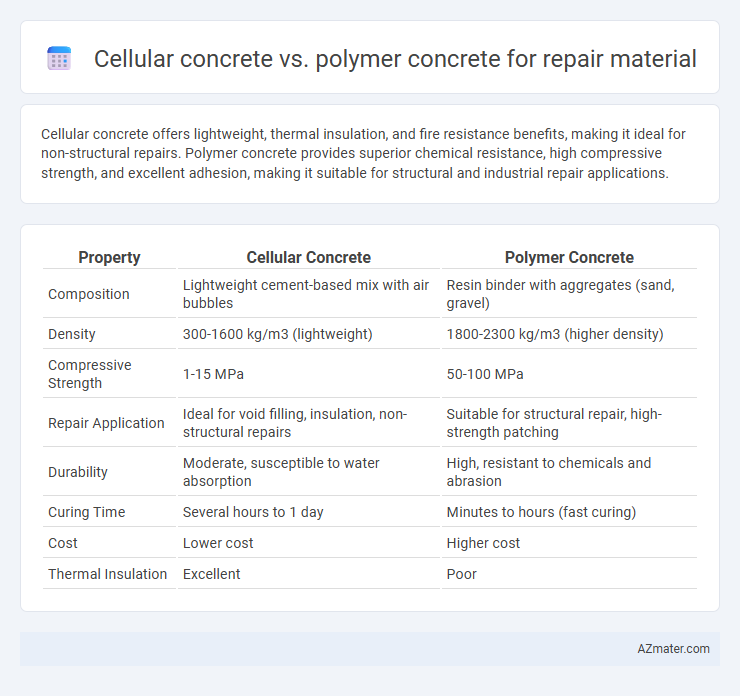Cellular concrete offers lightweight, thermal insulation, and fire resistance benefits, making it ideal for non-structural repairs. Polymer concrete provides superior chemical resistance, high compressive strength, and excellent adhesion, making it suitable for structural and industrial repair applications.
Table of Comparison
| Property | Cellular Concrete | Polymer Concrete |
|---|---|---|
| Composition | Lightweight cement-based mix with air bubbles | Resin binder with aggregates (sand, gravel) |
| Density | 300-1600 kg/m3 (lightweight) | 1800-2300 kg/m3 (higher density) |
| Compressive Strength | 1-15 MPa | 50-100 MPa |
| Repair Application | Ideal for void filling, insulation, non-structural repairs | Suitable for structural repair, high-strength patching |
| Durability | Moderate, susceptible to water absorption | High, resistant to chemicals and abrasion |
| Curing Time | Several hours to 1 day | Minutes to hours (fast curing) |
| Cost | Lower cost | Higher cost |
| Thermal Insulation | Excellent | Poor |
Introduction to Cellular and Polymer Concrete
Cellular concrete, known for its lightweight and high thermal insulation properties, consists of cement, water, and a foaming agent that creates air bubbles, making it ideal for repair applications requiring reduced load and enhanced durability. Polymer concrete incorporates polymer resins as binders instead of traditional cement, offering superior chemical resistance, high tensile strength, and rapid curing, which ensures effective structural repairs in aggressive environments. Both materials exhibit distinct advantages in repair contexts, where cellular concrete provides cost-effective thermal insulation and ease of handling, while polymer concrete excels in mechanical strength and environmental resilience.
Composition and Material Properties
Cellular concrete is a lightweight material composed of cement, water, and a foaming agent that creates air bubbles, resulting in low density and good thermal insulation properties. Polymer concrete consists of traditional aggregates bonded by polymer resins such as epoxy or polyester, providing superior chemical resistance, high compressive strength, and excellent adhesion to damaged substrates. While cellular concrete offers ease of application and thermal insulation, polymer concrete excels in durability and mechanical performance for critical repair applications.
Strength and Durability Comparison
Cellular concrete typically offers lower compressive strength, ranging from 1.6 to 8 MPa, making it suitable for non-structural repair applications, while polymer concrete boasts compressive strengths between 40 to 90 MPa, ideal for high-stress repairs. Durability of polymer concrete exceeds cellular concrete due to its superior chemical resistance and low permeability, resulting in enhanced resistance to freeze-thaw cycles, corrosion, and abrasion. In structural repair scenarios demanding long-term performance, polymer concrete provides a more robust and enduring solution compared to the lightweight but weaker cellular concrete.
Weight and Density Differences
Cellular concrete exhibits significantly lower density, typically ranging from 300 to 1600 kg/m3, making it much lighter compared to polymer concrete, which usually falls between 1900 to 2400 kg/m3. The reduced weight of cellular concrete enhances ease of handling and application in repair works, especially where load constraints exist. Polymer concrete's higher density contributes to superior mechanical strength and durability but adds more weight, impacting its suitability for lightweight structural repairs.
Workability and Application Methods
Cellular concrete offers superior workability due to its lightweight and flowable nature, making it ideal for filling voids and providing thermal insulation in repair projects. Polymer concrete exhibits excellent adhesion and chemical resistance, requiring careful surface preparation and typically applied through casting or troweling techniques for durable structural repairs. Both materials demand specific application methods to maximize performance, with cellular concrete suited for pumpable, expansive repairs and polymer concrete favoring precision patching and overlays.
Resistance to Environmental Factors
Cellular concrete exhibits superior resistance to freeze-thaw cycles and moisture penetration due to its closed-cell structure, making it ideal for outdoor repair applications in harsh climates. Polymer concrete offers excellent chemical resistance to acids and solvents, enhancing durability in industrial environments exposed to aggressive chemicals. Both materials provide enhanced environmental resistance, but selection depends on specific exposure conditions and mechanical performance requirements.
Cost Analysis and Economic Considerations
Cellular concrete offers lower material costs and ease of application, making it a cost-effective choice for large-scale repairs with moderate strength requirements. Polymer concrete, while more expensive due to resin components, provides superior durability and chemical resistance, reducing long-term maintenance expenses. Evaluating initial outlay against lifespan and performance is crucial, as polymer concrete may deliver better economic value in high-stress or corrosive environments despite higher upfront costs.
Suitability for Various Repair Scenarios
Cellular concrete offers excellent thermal insulation and lightweight properties, making it suitable for filling voids and non-structural repair in walls and floors, especially where weight reduction is critical. Polymer concrete provides superior chemical resistance, high compressive strength, and rapid curing time, ideal for aggressive environments like industrial floors, bridge decks, and structural repairs requiring durability. The choice depends on specific repair conditions, with cellular concrete favored for thermal and acoustic applications, while polymer concrete excels in high-load and chemically exposed scenarios.
Sustainability and Environmental Impact
Cellular concrete offers enhanced sustainability due to its lightweight and high thermal insulation properties, reducing energy consumption during production and in building applications. Polymer concrete, while more durable and chemical-resistant, often relies on non-renewable petrochemical resins, leading to a higher environmental footprint. The biodegradable fillers and lower embodied energy in cellular concrete position it as a more eco-friendly repair material compared to polymer concrete.
Conclusion: Choosing the Right Repair Material
Cellular concrete offers excellent lightweight properties and thermal insulation, making it ideal for non-structural repair and void filling in construction projects. Polymer concrete provides superior mechanical strength, chemical resistance, and durability, which is essential for structural repairs exposed to harsh environments. Selecting the right repair material depends on project requirements, where polymer concrete is preferred for high-strength applications and cellular concrete suits lightweight, insulating repairs.

Infographic: Cellular concrete vs Polymer concrete for Repair material
 azmater.com
azmater.com